This article will examine major reasons why the majority of Generation Z will be non-religious and not believe in God. According to 2018 Gallup Survey (America) the number of those that “never attend church or synagogue” increased from 13% in 2000 to 28% in 2018. In 2017, only 64% of those polled were ‘convinced that God exists; with 16% saying God, ‘probably exists, yet have a little doubt.’
The post-millennial generation, called Generation Z (Gen Z or iGen), has been label by various sources as those born between 1995/2000 and 2020. As of 2019 the mainstream of them are still in K-12 schools, and the older ones are in college or starting career jobs.
Concerning Generation Z teens and young adults, it has been suggested by a couple of studies that they will be one of the most conservative generations and tech-savvy quick thinkers. It is a bit early to guess the future views of current teenagers and pre-teens on issues like same-sex marriage, pre-marital sex and abortion. And it is likely they will marry across ethnic, racial and religious lines more than any other modern generation. More importantly, there is good reason to believe that they will be the most agnostic generation the world has seen since before the Medieval Period.
This article will look at some world population data; several studies (mostly US examination); present world facts and trends on Why Gen. Z will be non-religious; and our conclusion. At the end, it will offer some charts and images in the Appendix. Also, after you examine this article, check out: Why Generation Alpha and Z is Non-religious?
UPDATE:
According to the National Centre for Social Research (9/2017), “last year (2016) 53% of people described themselves as having ‘no religion.’ Among those aged between 18 and 25, the proportion was higher at 71%… when the National Centre’s British Social Attitudes survey begin in 1983, 31% of respondents said they had no religion.” http://www.bbc.com/news/uk-41150792
2019: U.S. “Americans claiming ‘no religion’ represent about 23.1% of the population, up from 21.6 in 2016. This equals the number of American Catholics or Evangelicals.
https://religionnews.com/2019/03/21/nones-now-as-big-as-evangelicals-catholics-in-the-us/
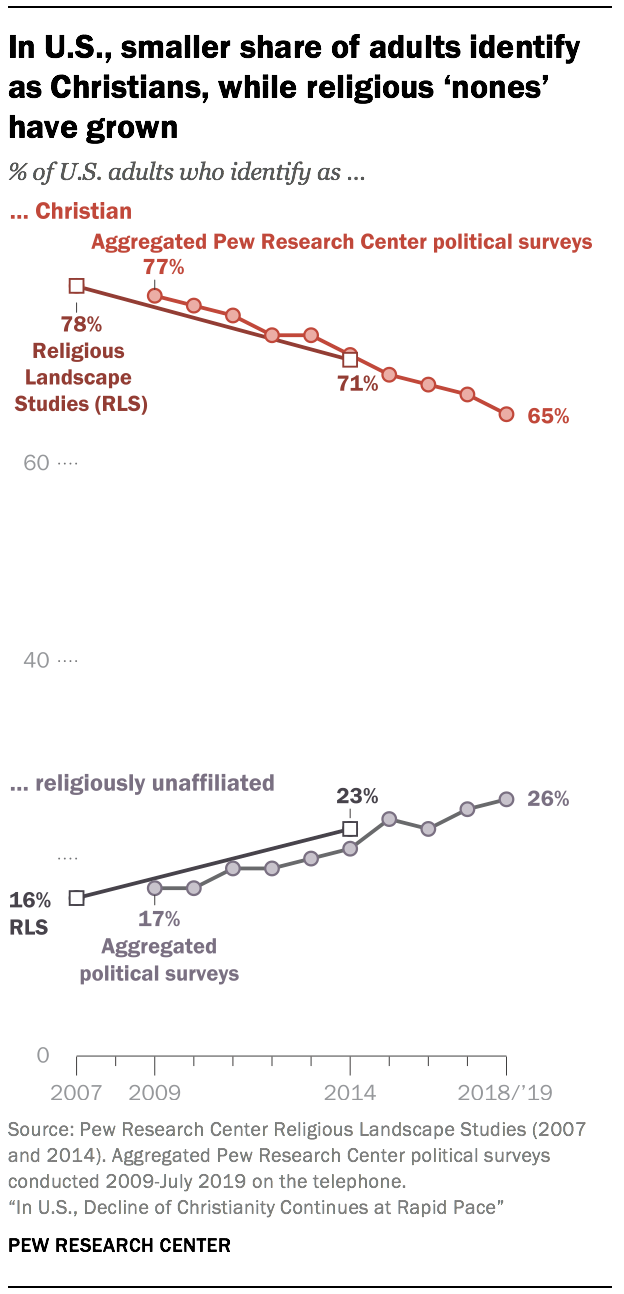
October 17, 2019: Pew Research Center has reported what we have been saying for years, since the incorrectly predicted an increase in the Christian and Muslims populations for 2030 and 2050 based on significantly wrong large percentages.
They have “an update on America’s changing religious landscape” and say that based on 2018 and 2019 surveys, 65% of Americans “describe themselves as Christians… down 12 percentage (%) over the past decade.”
Though Agnostics and Atheists are only 4% to 5% of the population, those that are “nothing in particular” have risen to more than 17%; but even this 22% is very low, because the non-practicing religions are more than 1/3 of America. Additionally, the study shows Church attendance (2019 before COVID-19) to be about 45% for those that attend at least once a month.
Moreover, there is a 13% increase in the last 10 years of nonreligious Millennials. Generation Z (born since 2000) will most certain reflect worst numbers.
https://www.pewforum.org/2019/10/17/in-u-s-decline-of-christianity-continues-at-rapid-pace/
Some World Population Data
By 2020, it is estimated that one-third of the U.S. population will be born after 1995. Today in India about 1 in 3 people are under age 20; and by 2020 it is estimated that the median age will be 29. Though China will have hundreds of millions of citizens under age 20 in 2020; it is projected that their median age then will be about 41 and due to their previous one and two child policies, the UN reports that China currently has the world’s largest number of the very elderly.
According to Eurostat Statistics (June 2016): “The population of the EU-28 on 1 January 2015 was estimated at 508.5 million. Young people (0 to 14 years old) made up 15.6%… working age (15 to 64) accounted for 65.6%… the median age …was 42.4… which was an increase of 4.1 years between 2001 and 2015.”
The CIA World Factbook (2016) listed the MEDIAN AGE (the quantity at the midpoint) for the World at 30.1, 29.4 years for males and 30.9 for females. March 2015 Pew Research Center did an article, Median Age of World Population, 1950-2050, which displayed it going from 23 in 1950 to 28 in 2010 and projected it to rise to about 32 by 2020. In June 2017, the world population is estimated to be between 7.4 billion and 7.5B – with 1.38B in China, 1.3B in India and 326 million in the United States. The UN predicts a 2020 population of 7.76 billion with a median age of 31 and 8.5 billion in 2030 with a median age 33. Based on this data there will be over 2.5 billion Generation Z persons in 2020 – about 1 in 3 persons.
The World Bank of the United Nations showed that our World’s post World War II population age is rising significantly. They report the age 0 to 14 year population falling from a high of 38% in 1966 to about 26% in 2015. http://data.worldbank.org/indicator/SP.POP.0014.TO.ZS
March 2016 the U.S. Census Bureau released one of its International Population Reports titled An Aging World: 2015. It stated, “The world population is aging rapidly. Today the older population (aged 65 and over) represents 7% or more of the total population in many parts of the world… By 2050, only 33 countries are projected to have an older population comprising less than 7%… a substantial reduction from 115 such countries in 2015… the older population will exceed 21% in 94 countries… By 2050 in contrast to the 150% expansion of the age 65+ population… the youth population (under age 20) is projected to remain almost flat, 2.5 billion in 2015 and 2.6 billion in 2050…”
http://cdn.cnsnews.com/attachments/census_bureau-an_aging_world-2015.pdf

World Population: February 2018 ≈ 7.6 Billion
Small Studies and Unreliable Bounces
Generation Zers in America have been home schooled more than the last several generations and most are close to their parents. According to a Goldman Sachs study they have more conservative ideas than the previous Generation X; and nearly 70% were ‘self-employed (teaching piano lessons, selling goods on ebay, etc.)’ by a Harvard Business Review study. According to Dr. Joan Hope (editor of Dean & Provost), in her article, Get your campus ready for Generation Z (September 2016; The Successful Registrar, Volume 16), this generation started attending college in 2013. The article reported that “Gen Zers’ participation in religion is up compared with previous generations. When asked about spirituality, 47 percent said they were religious, and an additional 31 percent said they were spiritual but not religious. Church attendance is also up during young adulthood, with 41 percent saying they attend weekly religious services, compared with 18 percent of millennials at the same ages, 21 percent of Generation X, and 26 percent of baby boomers.”
After this study, many Christian journalists, professors and ministers were citing these findings and looking forward to an influx of new Church members or Christian students; but other studies and facts suggest otherwise. ChristianPost.com (May 2016) and the WashingtonTimes.com (May 2016) were both running Thom Rainer’s article Ten Things You Should Know about Generation Z, with Dr. Hope’s research. BlackChristianNews.com (May 2016), MinistryTodaymag.com (May 2016), Ulsbc.org (May 2016), Youth Specials (July 2016), Recongress.org (2017) and a few others did likewise. The DailyMail.co.uk (September 2016) was following a British study of this generation vs the previous and being conservative; through that study admitted it was too early to tell the future.
First, understand that when these studies were done that about 1/5 to 1/4 of the so-called Generation Z had not even been born yet; another quarter were not out of kindergarten; and depending on when you start their generation (some use 1995 and others 2000), from none to very few of them were even out of their teens. Thus, to say we understand their future choices and mindsets is very premature and unreliable.

Gallup Studies
There are other reasons to question the findings of Dr. Hope’s study which – implied that this new post-millennial generation will be more church going or religious that the last generation Y (or millennials; born between 1980 and 1995). They include: the age and survey size of this research citing 41% church attendance, versus other research by Gallup, the Pew Research Center, and others that use larger sample sizes, and more polling and questions; seeing the difference in occasional up ticks versus trends; taking a global look; and using holistic quantitative methods.
For example, notice the follow data by Gallup (founded in 1935 as the AIPO):

2018 Update (link at end of Gallup section): Only 50% were members of a church or synagogue; down 5% from 2016 and 18% from 2000; and 20% from 1992. And, of those surveyed in 2018 – 68% had not attended church or synagogue in the last 7 days, compared to 56% in 2000 or 59% in 1992.
Moreover, those saying they ‘seldom’ or ‘never’ attend:
2000: 27% s + 13% n; 2018: 25% s + 28% n (double amount of never)

http://www.gallup.com/poll/200186/five-key-findings-religion.aspx
Viewing the Gallup study of Americans from 1938 to 2016 shows several key findings. It reveals a significant downward trend in church membership, as well as the fact that there are many years that produce increases on bounces in church membership from the previous year, but that it did not change the trend of an average 20% drop from WWII’s end in 1945 with about 75% church membership to about 55% 70 years (and about 2 or 3 generations) later. And note that Dr. Hope’s finding was from this bounce period.
Additionally, notice that according to Gallup.com (December 2016), “Gallup’s longest-running religious service attendance question asks, ‘did you, yourself, happen to attend church, synagogue or mosque in the last seven days, or not?’ In 1939, when Gallup first asked this question, 41% said ‘yes.’ That percentage dropped to 37% in 1940 and rose to 39% in 1950. It continued to climb, reaching as high as 49% at multiple points in the 1950s. Attendance then settled down to figures around 40% for decades, before dropping to 36% for the past three years.” Thus, Gallup’s findings reveal a 5% lower difference (36%) than the stated 41%; and a current flat line. Though Gallup says, “data in 2016 show a leveling off in downward trends in church attendance…” it also said, “this may be a short-term phenomenon… it will take years of data collection to determine if formal religiosity will continue to decrease or level off.”
Updated Gallup Polls (2018):
What is your religious preference? % Answering None or did not answer:
1960 – 2%; 1980 – 7%; 2000 – 10%; 2010 – 18%; 2015 – 21%; 2018 – 24%
How important would you say religion is in your own life – ‘not very:’
1992 – 12%; 2000 – 12%; 2005 – 16%; 2010 – 20%; 2015 – 22%; 2018 – 26%
![rffohjyng0ow4xdsmt6s8q[1].png](https://thetruthsource.files.wordpress.com/2019/02/rffohjyng0ow4xdsmt6s8q1.png?w=616)
In 1998, 52% of those polled stated that Religion is ‘losing its influence’ in America; 20 years later in 2018, 76% said the same.
https://news.gallup.com/poll/1690/religion.aspx
Pew Research Center:
The Pew Research Religious Landscape Study (2015) surveyed “more than 35,000 Americans to offer a detailed look at the current religious composition of U.S. adults…” It noted that “in 2007, 78.4% of U.S. adults identified with Christians groups… seven years later that percentage has fallen to 70.6%… there are roughly 173 million Christian adults in the U.S. today, down from about 178 million in 2007.” The study also show an increase in the unaffiliated of 6.7% from 16.1% in 2007 to 22.8% in 2014 – 56 million adults in America without a religious affiliation. Chart Image can be seen at the end of this article showing the representation of this percentage. Note that was 2014 and the ‘Nones’ were not only increasing, but are parents to a major portion of the Generation Z children.
| Pew Research Religious Landscape Study Table (in part) – Age distribution by religious group: | ||||
| 18-29 | 30-49 | 50-64 | 65+ | |
| Catholic | 17 % | 33 % | 29 % | 20 % |
| E. Protestant | 17 % | 33 % | 29 % | 20 % |
| M. Protestant | 16 % | 29 % | 29 % | 26 % |
| Muslim | 44 % | 37 % | 13 % | 5 % |
| Unaffiliated (r.n.) | 35 % | 37% | 19 % | 9 % |
| 2014 Data; E. = Evangelical; M. = Mainline; r.n. = religious ‘nones’ | ||||
The above table shows that the parents of Generation Z children are roughly twice as non-religious as those before them and more than three times that of their grandparents. This is a most significant tell of the future. “Train up a child in the way they should go; and when they are adults they will not depart from it (Proverbs 22:6).” A substantial portion of children will follow their parent’s religion – whether Christianity, Islam (Muslim), Hinduism, Buddhism or Judaism.
The data from the Pew Religious Landscape Study revealed many more details such as about American views of Christian beliefs and their practices. Only 63% of the 35,071 people polled were ‘absolutely certain’ in their ‘believe in God.’ That number was down 8% from 2007’s 71%. Also, those who absolutely did ‘not believe in God’ rose from 5% in 2007 to 9% in 2014. The table below shows that the unaffiliated jumped 13.6% from their 2007 study. It should be noted both that a small percent of the unaffiliated believe in God and attend church; however, based on European past statistics and trends, as the parents separated from the church, the children followed and the vast majority of both became non-religious.

The study also showed other important trends as seen in the table below. Namely Millennials attendance was almost half of the pre-WWII ‘Silent Generation.’ And belief in heaven fell to 68%. Also, the fact that only 56% to 59% truly believe in Hell and Judgment reveals to truth of their Christianity – most that say they are Christians, know little about Jesus’ doctrines.

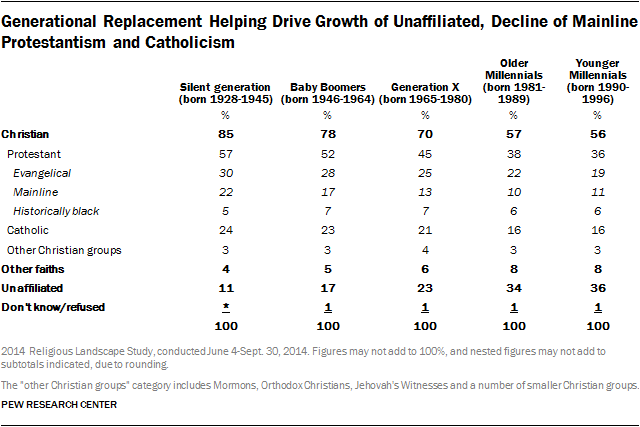
National Geographic (April 2016) article:
‘The World’s Newest Major Religion: No Religion’
They write, “You don’t usually think of churches as going out of business, but it happens… March 2016… the U.K. Mennonites held their last collective service. It might seem easy to predict that plain-dressing Anabaptists – who follow a faith related to the Amish – would become irrelevant in the age of smartphones, but this is part of a larger trend. Around the world, when asked about their feelings on religion, more and more people are responding with a meh. The religiously unaffiliated, called ‘nones,’ are growing significantly. They’re the SECOND (2nd) largest religious group in North America and most of Europe. In the United States, nones make up almost a quarter of the population. In the past decade, U.S. nones have overtaken Catholics, mainline protestants, and all followers of non-Christian faiths…” As with other Researchers such as Pew, they state that the nones will decline by 2050 and be pasted by the religious – but this is based on Muslim and Hindu growth and speculation which will be addressed later in this article. (note ‘meh’ – expressing lack of interest; image from article in Appendix.) http://news.nationalgeographic.com/2016/04/160422-atheism-agnostic-secular-nones-rising-religion/
| The HuffingtonPost.com May 2015 article, Millennials are the Least Religious Generation Yet, And Here’s… Why, stated “’Unlike previous studies, ours is able to show that Millennials’ lower religious involvement is due to cultural change, not to Millennials being young and unsettled,’ Dr. Jean Twenge, a psychologist at San Diego State University and of the researchers, said in a written statement… referring to studies like (the) 2014 Pew survey. …Twenge said, ‘we found that religious involvement was low when individualism was high …Individualism is a cultural system that places more emphasis on the self and less on social rules. Individualism can conflict with religion, especially as religion usually involves following certain rules and being part of a group’.” Twenge was cited in the PLOS study below. |
PLOS.org Study: ‘Generational and Time Period Differences in American Adolescents’ Religious Orientation, 1966-2014
PLOS reported, ‘in four large, nationally representative surveys (N = 11.2 million), American adolescents and emerging adults in the 2010s (Millennials) were significantly less religious than previous generations (Boomers, Generation X) at the same age. The data are from Monitoring the Future studies of 12th graders (1976-2013), 8th and 10th graders (1991-2013), and the American Freshman survey of entering college students (1966-2014). Although the majority of adolescents and emerging adults are still religiously involved, twice as many 12th graders and college students, and 20%-40% more 8th and 10th graders, never attend religious services. Twice as many 12th graders and entering college students in the 2010s (vs. the 1960s-1970s) give their religious affiliation as ‘none,’ as do 40%-50% more 8th and 10th graders…” (one of their charts from download is below)
http://journals.plos.org/plosone/article?id=10.1371/journal.pone.0121454
Download from PLOS.org (2014)

European 2014-2016 Study
According to the 2018 article by The Guardian, ‘Christianity as default is gone’: the rise of a non-Christian Europe, “…The survey of 16- to 29-year-olds found the Czech Republic is the least religious country in Europe, with 91% of that age group saying they have no religious affiliation. Between 70% and 80% of young adults in Estonia, Sweden and the Netherlands also categorize themselves as non-religious. The most religious country is Poland, where 17% of young adults define themselves as non-religious, followed by Lithuania with 25%.



Barna Study: The State of the Church 2016
They report, “the Christian church has been a cornerstone of American life for centuries, but much has changed in the last 30 years. Americans are attending church less, and more people are experiencing and practicing their faith outside of its four walls. Millennials in particular are coming of age at a time of great skepticism and cynicism toward institutions – particularly the church… Based on a large pool of data collected over the course of this year, Barna conducted an analysis on the state of the church… in America. …Almost three-quarters of Americans (73%) say they are a Christian, while… 20% claim no faith at all (that includes atheists and agnostics). A fraction (6%) identify with faiths like Islam, Buddhism, Judaism or Hinduism…”
The article continues: “Even though a majority of Americans identify as Christian and say religious faith is very important in their life, these huge proportions belie the much smaller number of Americans who regularly practice their faith. When a variable like church attendance is added to the mix, a majority becomes the minority. When a self-identified Christian attends a religious service at least once a month and says their faith is very important in their life, Barna considers that person a “practicing Christian.” After applying this triangulation of affiliation, self-identification and practice, the numbers drop to around one in three U.S. adults (31%) who fall under this classification. Barna researchers argue this represents a more accurate picture of Christian faith in America, one that reflects the reality of a secularizing nation.
Another way Barna measures religious decline is through the “post-Christian” metric. If an individual meets 60 percent or more of a set of factors, which includes things like disbelief in God or identifying as atheist or agnostic, and they do not participate in practices such as Bible reading, prayer and church attendance (full description below), they are considered post-Christian. Based on this metric, almost half of all American adults (48%) are post-Christian.”

When looking at the fact that fast approaching half of the Americans who say they are ‘Christian’ have “not attended a church service within the past six months (unchurched),” one can see how like Europe, Canada, Central and South America – America also is becoming a secular nation. Barna defines ‘Churched’ as “churchgoers who have attended a church service – with varying frequency – within the past six months (not including …a wedding or funeral).”

It is worth noting that Barna stated, “…practicing Christians tend to be more generous overall than their secular counterparts: 96 percent of practicing Christians gave to a church or a nonprofit, compared to 60 percent among atheists and agnostics.” Another fact worth looking at is that only 34% of American adults say they read the Bible. The apostle Paul said, ‘faith comes by hearing… the Word of God (Rom. 10:17),’ and he also quoted the prophet Habakkuk several times saying, ‘the just shall live by faith (Rom. 1:17; Gal. 3:11; Heb. 10:38; Hab. 2:4).’ If a Christian cares not for the ‘word of God,’ how can they continue to ‘live by faith?’ They will become lukewarm; they will as seen in these studies – relax or no longer continue to believe in heaven, hell, the resurrection and the Judgment, or in repentance from evil works and salvation through Jesus Christ.



WHY the majority of GENERATION Z will be Non-Religious
Let us start with the understanding that Generation Z is not from one nation alone, but all countries of the world; thus this topic should be viewed in a holistic manner. Next, what is it to be religious or non-religious? Webster’s Dictionary (1828) defines ‘Religious’ in part as “godly; loving and reverencing the Supreme Being and obeying His precepts; as a religious (person)… Devoted to the practice of religion; as a religious life… Teaching religion; containing religious subject or the doctrines and precepts (laws, principles) of religion… religious observance of vows or promises… appropriated to the performance of sacred or religious duties; as a religious house.” Non-religious is not being religious; or not believing or being involved in a religion.
Based on these definitions, one can see that being religious is more than being listed on a country’s or denomination’s census; it is a matter of ‘word and deed’ or ‘faith and practice.’ And a sad fact is, according to the Pew Research Center (pewforum.org, August 2016), that “roughly eight-in-ten religious ‘nones’ say they were raised with a religious affiliation; while just 21% were raised religiously unaffiliated…” This shows that a significant portion continues in the home’s religious or traditional environment; and also that even those raised in religious homes are walking away from religion. TheTruthSource offers Five Major Reasons why the majority of Generation Z will be non-religious. The following are not particularly in order of importance or weight.
- The 2050 MISTAKE about Hindus and Muslims: Pew Research and other studies are correct (assuming the world age as we know it has not ended – see Matthew 24:29) when they say that “mega economies in 2050 are projected to include a country with a Hindu majority (India), a Muslim majority (Indonesia)…” But they do not explicitly account for several factors when they make their assumption (as seen below) that 33 years from now practicing Muslims, or even Muslims will increase by 1 billion, Christians by 750 million, and Hindus by 350 million. There are five major factors that are not mentioned or possibly considered in their projections. Four of these are: war, poverty, formal education, and revolutions and politics; all which will be addressed later. The other factor is change in culture.

Now, although changes in culture are influenced and affected by the environments the people live in; including political, war and peace, education, internet and social media access, and religious tradition – all which will be considered later; here we offer some facts and general conclusions.
Currently (2017), a little over 3 in 4 persons (77%) living in India claim to be Hindu. But studies have shown a significant drop in just the last 10 or so years. The Times of India reported in 2013 that ‘more Indians have stopped believing in God.’ Also, WIN/Gallup’s Global Index of Religion and Atheism revealed that there was a 6% increase in their non-religious population from 2005 to 2012 (81%). Thus, from about 87% ‘Hindu’ in 2005 to 77% in 2017, we see a very substantial drop. One study presented by Calcutta’s The Telegraph (2015) revealed that ‘nearly 30% of the people (in India) do not believe in God;’ which shows the problem of simply saying Government Statistics that 77% of India is Hindu or Religious. But the question should be ‘why such a momentous drop in 12 years?’
Our article Young Hindus in India no longer believing in the Supreme God goes into more detail with that answer. The short answer is somewhat four-fold: changes in available information (internet and education); their young population talking and supporting each other (social media, universities, etc.); changes in their culture as it relates to coercion and punishment by previous administrations; and likely future change in RELIGION by BIRTH CERTIFICATE were the great majority of the population is forced to choose a Religion at birth – and of course as since around the world it is almost always the country’s traditional religion, which is almost always the religion of the parents.
As to the Muslim population, the reasons are the same or similar. However, when it comes to Islam and Muslims leaders – religious, political, educational and self-proclaimed Jihadists – we find a very different type of coercion (compulsion). In India, those who leave their Hindu religion could be whipped or shunned by relatives and mocked or bawled at by leaders – and we discovered they have open support from others; yet, the case with most Muslims and nearly all in the MENA (Middle East; North Africa) region is quite different. There is little or no support from others to leave, often on threat of jail or death. There is little or no opposition to their state mandated religion – ISLAM – due to duress, legal penalties and yes, even death. Before some object, consider how far reaching ISIS/IS/Al-Qaeda/the Taliban and their affiliates are. Additionally, there is the fact the most are: illiterate and do not even know their own doctrines; non-practicing; or forced or coerced into religious service attendance. And there is also a significant portion of their populations Forced to be Muslim. As laws, crisis, wars, education and freedoms change; we will see a vast and significant drop in practicing Muslims.
- EDUCATION (formal): Education is controlled by State, local and National Governments; and in that since it is significantly affected by the politics, freedoms and restrictions of those governments. For example, Iran will not allow the teaching of Christianity; but most Western ‘Christian’ nations will allow the teaching of all religions. The following is from TheTruthSource: Sources of Influence: Part III
“EDUCATION comes from many sources; the main ones being parents, grandparents, siblings, guardians, acquaintances, ministers, occupational instructors and possibly most importantly from teachers and professors in Schools and Universities… (In Western Nations) the fact that most or all of the early colleges/universities are no longer controlled by their original founding denominations displays the power of social changes in public religion and politics.
According to the Council for Christian Colleges and Universities (CCCU), “the U. S. Department of Education reports that there are more than 4,000 degree-granting institutions of higher education in the U. S. alone. About 1,600 of those are private… and about 900 of these …describe themselves as ‘religiously affiliated.’ Their study showed enrollment in Religious-Affiliated Institutions (RAI) increased almost 16 % from 1990 to 1998, compared to only 5.3 % of all colleges or 3 % of all public institutions. Yet, non-sectarian or non-RAI private institutions increased at close to the same rate.
According to the Digest of Education Statistics: 2007complied by the National Center for Education Statistics, using statistics from the U. S. Dept. of Education, they found that “in the fall of 2007, about 73.7 million people were enrolled in American schools and colleges. …In 2004, about 1.3 billion students were enrolled in schools around the world; …685 million were in elementary… 503 million were in secondary…”
THE CHANGE IN PUBLIC SCHOOLS and UNIVERSITIES since the 1960s and especially since the 1980s and new textbooks, HAS DIRECTLY INFLUENCED an Increased in the Non-Religious in SOCIETY. It has significantly influenced leaders and teachers to the point of changed values, beliefs, methods and laws in not only the United States, but throughout the World. For more on how Education affects the world, see the United Nations brochure: Education Transforms Lives:”
http://unesdoc.unesco.org/images/0022/002231/223115E.pdf
How children are educated, the history and beliefs they are imprinted with, directly and momentously affects their future beliefs and practices. The teaching of evolution science (cosmic, chemical and biological), and the policy of separation of church/God and state/secular world in Western Nations, has had one of the one important impacts on the move of their populations from religious to non-religious. Likewise, wars, poverty and crisis that cause Muslim children to not attend schools (Madrasas), along with the rise in use of social media and increase in social freedoms, has and will continue to cause Generation Z children to leave the Islam religion.
Studies show a significant number of Muslim children are attending Christian schools in Western nations; and that according to ‘State of the World Children Report -2016’ by UNICEF, about 34% of the children from Muslim families, 25.9% from Hindu families and 25.6% from Christian families did not attend pre-school.” Moreover, according to India’s National Survey for Estimation of Out-of-School Children (2014) more than 60% of children dropped out of school before completing grade 3.
According to UNDP the literacy rates of women in Arab countries is around 55%. In Sudan and Yemen, 45% of girls do not attend school. In areas controlled by the Taliban, reports have revealed that they often ban girls from schools. In conflict countries, such as Syria and Afghanistan the majority of boys and girls do not attend schools (Madrasas). In Afghanistan, the UN and CIA World Fact Book reported that about 85% of women have no formal education and are illiterate and that it is common for girls to be promised in marriage before they are teenagers and even married by 13 – with 60% of girls married by age 16 – most forced to marry men 3 times their age, who they met at their wedding. And the same can be said for many other nations such as Indonesia or Bangladesh.


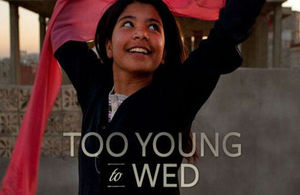




The UNHCR reported that in Lebanon, Syria and Iraq between 65% and 75% of girls do not attend school and the same came be said from perhaps most of the boys. These facts will contribute to the change in the mind set of Generation Z children; namely in a decade or so when Muslim women will have choices and freedoms to be educated, married for love and practices their belief according to free perceptions of truth.




- INTERNET and SOCIAL MEDIA: India has had state-owned internet (Tata Communications, headquartered in Mumbai; formerly VSNL) since 1995. The service was very expensive at the time so it only had about 25,000 subscribers the first year. In 2004, it opened up broadband, but access was still low due to cost and limits on wire transfer capabilities. After 2010, India had 3G and 4G private and public providers and in 2017 reached about 400 million subscribers. Thus, it has only been in the last few years that its young adult and children population has explored and surfed the internet in a similar manner as Western Countries have for two decades; in doing so, many ‘Hindus’ are questioning and leaving their religion and practices. And as the internet opens up throughout the MENA countries, results will be comparable.

Additionally, as of April 2017, India was just behind top ranked United States with 213 million Facebook users; and Indonesia is fourth with 111 million; Turkey also makes the top 8 with 48 million users. Social Media not only comes with its influences, but provides a support system to friends and acquaintances. Through such Social Media connections more Hindu and Muslim people are encouraging and supporting freedom of choices in life and thus religion.
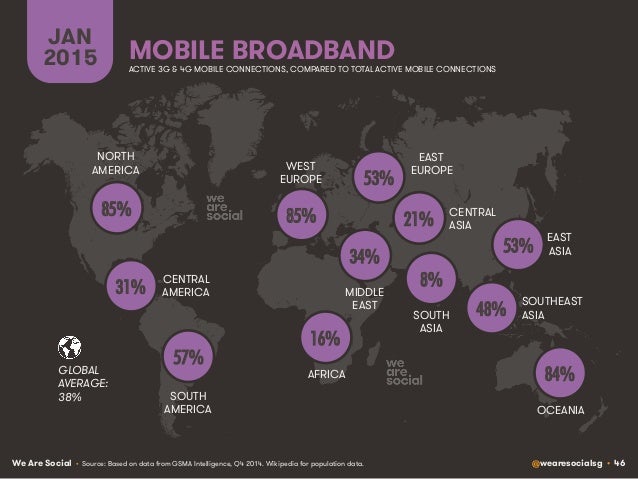
For example; as of February 2017, Indian Atheists (launched 2009) on Facebook had over 155,000 followers. Other sites like Liberal Indian Atheists had thousands of followers. A 2014 Rice University survey of 1,763 scientists from India reveals that only 27% ‘believe in God.’

- POLITICS; Poverty, Crisis and War: In our article Forced to be Muslim we offer a section on ‘National and Sharia (Quran) Islamic Laws,’ which reveal how most Muslim nations restrict religious freedom and choices and impose penalties to people that try to ‘convert Muslims.’ The laws in most of these Muslim countries also control much of family life and culture.



There are 193 member nations in the United Nations and more than 110 gained their sovereignty after World War II and the formation of the UN in 1945. History and prophecy tell us that crisis, wars and coups will continue until the end of the world. Nevertheless, the conflicts in Syria and other such nations will come to an end – or at least a long pause – and freedoms and culture changes will come as they have over time in India and are in Egypt, and likewise, in other nations of Asia and Africa. And with these freedoms will come a change in the practices and beliefs of Muslims.
Revolutions and war will eventually put an end to the current level of Islamic control and coercions. Also, wars and crisis have directly affected migration which also has a way of bringing change to traditions of the people that migrate.
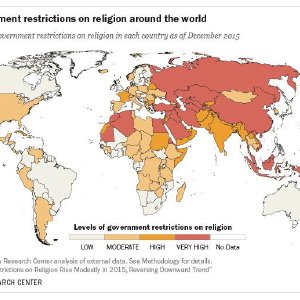
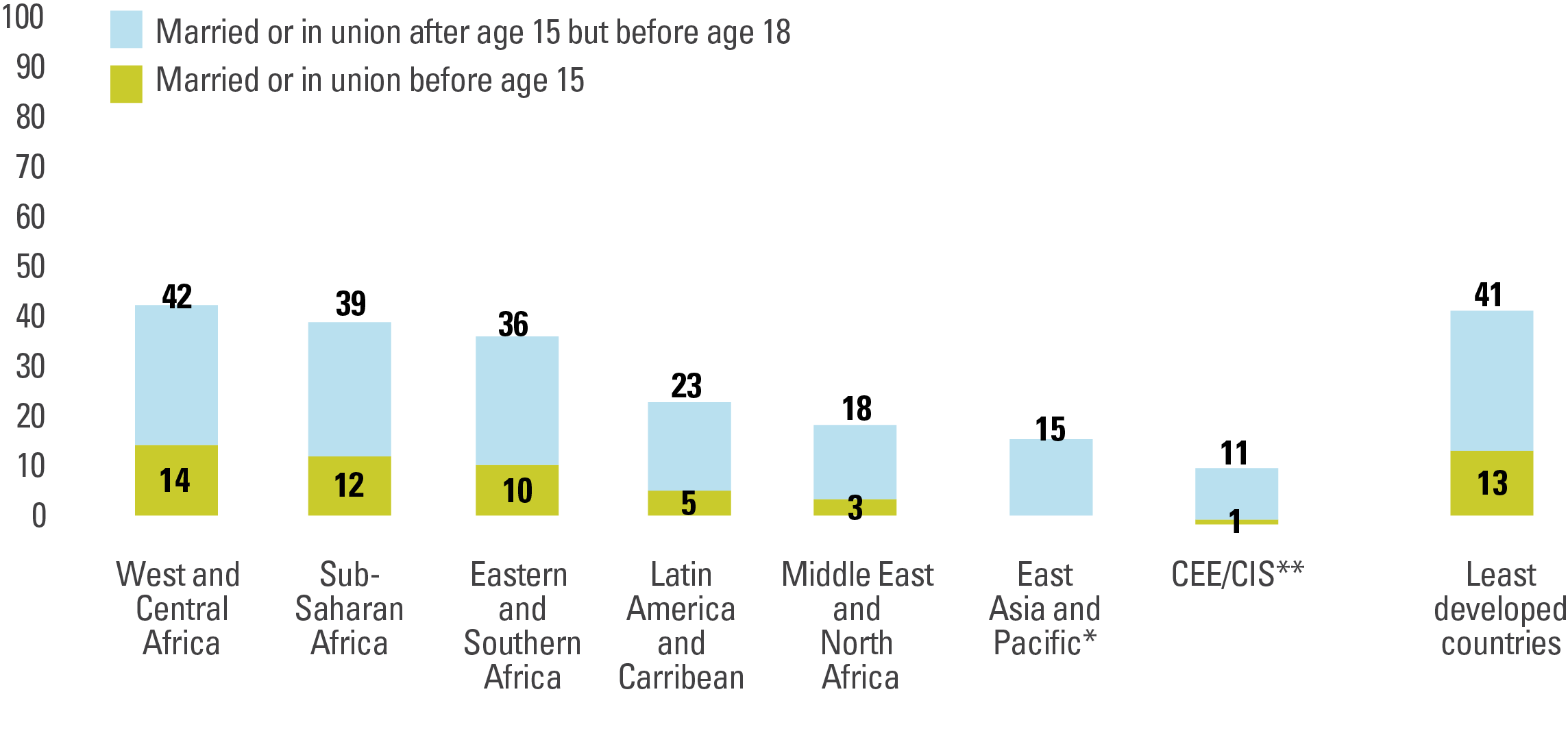
- CHANGE OF HEART: There are many reasons that people change their passions, practices and beliefs. But among the top as related to no longer being religious, such of the top have been because they saw their leaders, ministers, priests, imams and caliphs as hypocrites. Such because they sought power or money more than following the God of Abraham and His words given through the prophets and apostles.
Many left because they found error or falsehoods in their religion’s doctrines. Some left because they no longer believed their churches and mosques’ stance on social issues such as abortion, same-sex marriage or homosexuality. Many stopped believing in Heaven, Hell, the Resurrection and Judgment. And in many churches the lack of true worship and praise and teachings killed the church and repelled members.

Our article Decline of the Catholic Church tells of 8 reasons why tens of millions have left the Catholic Church, including the way they handled the ‘sex-scandal’ or sexual abuse by priests. According to two Pew Research studies in 2015; “half of U.S. adults raised Catholic have left the church;” and “Catholicism is losing members faster than any denomination.” In addition to the other reasons Latin Americans are leaving the Catholic faith, in 1999 the Vatican stated that Latin America had only 18% of the world’s priests and 42% of the world’s Catholics. By 2012, it was noted that in Cuba, there was only 1 priest per approximately 18,000 to 19,000 followers. Below is image is from 2014 for data from previous years – now 5 years later (2017) it several more percent have left the Catholic religion and joined the Unaffiliated.

Our articles The Non-religious: 2016; Religion: Britain not a Christian Nation and Religion: Sweden not a Christian Nation show that former strong “Christian Nations” are trending to non-religion and atheism/agnosticism; and most Western Nations of Europe and America already see that their practicing Christians no longer make up the majority of their populations.
In Conclusion
In 2016, TheTruthSource did a Quantitative Analysis: the World and found that less than 10% of the world’s population are practicing Christians; and that 45% to 60% of the world’s population is non-religious. China and India make up over 2.7 billion of the world’s 7.5 billion people (2017). And that 36% of the world’s population is together about 97% non-Christian and approximately 75% to 80% non-religious (China about 89% non-practicing any religion and India statistics are biased by ‘Hindu at birth’ governmental enforcement; but a closer look reveals that likely 60% to 70% are not practicing). This fact alone makes at least a quarter (25%) of the world non-religious.
(2017 by Millions of Muslims as listed by UN or their Government’s statistics) MENA’s population (Egypt, Iran, Algeria, Morocco, Iraq, Saudi Arabia, etc.) is estimated about 400m + Indonesia (200m+) + India (160m+) + Pakistan (175m+) + Bangladesh (130m+) + Nigeria (75m+) + Turkey (70m+) and others gives us about 1.7 billion Muslims or 22.7% of the world’s population. It is the opinion of TheTruthSource that the next generation will have more freedoms and we will see a decrease of 20% to 30% in these percentages as far as those practicing Islam. And even more so for the Hindus: India (950m+) + Bangladesh (12+m) + Indonesia (4+m) + Pakistan (3.3+m) + Sri Lanka (2.8+m) and others = about 1.1 billion Hindus or 14.7% of the world’s population. Thus, Muslims (1.7 billion; 22.7%) + Hindus (1.1 billion; 14.7%) + China’s non-religious (1.38 billion x 89% = 1.23; 16.4%) = about 4.18 billion or just under 56% (55.7%) of the world’s population.
It is the calculated opinion of TheTruthSource that if the world survives three more decades that there will be much more freedoms in India and MENA and when allowed to choose and express their true beliefs we will find likely less than half of the current Muslim and Hindu adherents, and or their children, practicing those religions. Thus, we could easy find, even with China becoming more religious and but having less births per 100,000 than other regions – the WORLD NON-RELIGIOUS POPULATION (2030) at 55%: China 15% + non-religious from previous Muslim/Hindu populations 15% – 20% + current percentage of the Non-Religious 1.1 billion or 14.7% + Change in Christian population or true practicing Christians 500+ million 6% – 8% + increase in non-religious from religions other than Christianity, Islam or Hinduism (which are about 15% of 2017 world population) of 1% – 3% = 53% to 60% Non-Religious in 2030.
While “the Lord …desires that none should perish but that all should come to repentance (2 Peter 3:9)” and “wants all people to be saved in the resurrection (see Dan. 12:2; John 5:29) and come to a knowledge of the truth (1 Timothy 2:4);” “all day long the Lord God has held out His hands to an obstinate people… following their own thoughts (Isaiah 65:2).” And it appears the Generation Z will certainly follow their own dreams, imaginations and thoughts and even many more of them join the ranks of the non-religious.
APPENDIX of Images and Charts
Image from Pew Research Center (August 2016); Why America’s ‘nones’ left religion behind.


Other Images and Charts











